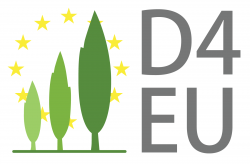Dendromass4Euope (D4EU) aims to establish Short Rotation Coppices (SRC) with different poplar hybrids. Related with that, D4EU implements a dedicated monitoring and environmental impact assessment to avoid any impact on protected species like the European black poplar (Populus nigra) that might be caused by D4EU plantations. One scenario is often raised by nature conservation authorities in relation with SRC. Namely, pollen ore seeds of SRC poplars could force a genetic introgression into the native genepool of black poplars. On the one hand, this scenario is highly improbable because SRC are harvested before the trees become mature and start flowering and fructification. On the other hand, there are many old poplars planted in European landscapes that belong to non-native species and hybrids which definitely do cause genetic introgression. Now, we want to know if there are still autochthonous black poplars growing around our SRC. Matthias Meyer and colleagues from the Research Group for Molecular Tree Physiology (TU Dresden) have collected samples from native rejuvenation in gravel pits last week. These samples will be used for genetic investigations. Afterwards we will know if the sampled individuals are already influenced by a genetic introgression from other poplar species which have been planted in Slovakia since many years.
The picture shows Matthias Meyer with a juvenile poplar. By the way, it is no surprise that this little tree starts growing in a gravel pit. Wild seedlings of black poplars need moist mineral soils with no other vegetation which would shade them. They find just perfect conditions in some highly human-influenced locations like gravel or sand pits. In the background, you can see old hybrid poplar forest stands that were planted many decades ago.
